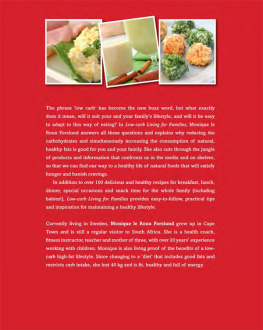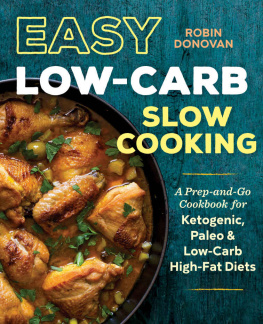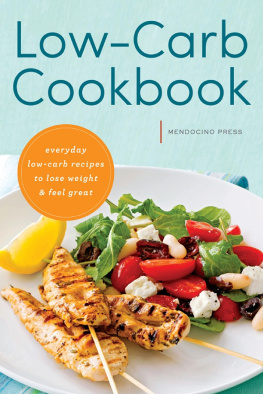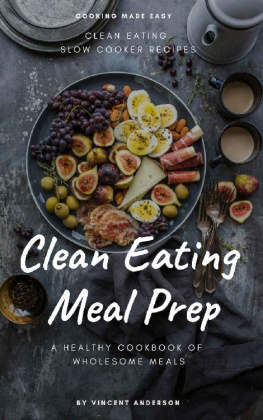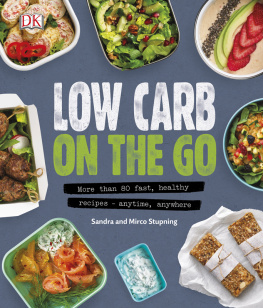
Published in 2013 by Struik Lifestyle
an imprint of Random House Struik (Pty) Ltd
Company Reg. No. 1966/003153/07
Wembley Square, Solan Road, Cape Town, 8001
PO Box 1144, Cape Town, 8000
www.randomstruik.co.za
Adapted from LCHF fr hela familjen, published by Pagina Frlags AB/Optimal Frlag in 2012
Copyright in published edition: Random House Struik (Pty) Ltd 2013
Copyright in text: Monique le Roux Forslund 2013
Copyright in photographs: Pagina Frlags AB/Optimal Frlag 2013
All rights reserved. No part of this publication may be reproduced, stored in a retrieval system or transmitted, in any form or by any means, electronic, mechanical, photocopying, recording or otherwise, without the prior written permission of the publishers and copyright holders.
Publisher: Linda de Villiers
Managing editor: Cecilia Barfield
Editor and indexer: Joy Clack (Bushbaby Editorial Services)
Designer: Helen Henn
Photographers: Mikael Eriksson, Monica Dart, M Industries and Monique le Roux Forslund
Proofreader: Laetitia Sullivan (Bushbaby Editorial Services)
ISBN: 978-1-43230-124-8 (Print)
ISBN: 978-1-43230-314-3 (ePub)
ISBN: 978-1-43230-315-0 (PDF)
Acknowledgements
I would like to thank the three hearts in my life: my children Daniel, Amilia and Lisa who taste, eat and enjoy my food. I truly appreciate your opinions and constant support. You are the best!
A huge thank you to my mom, who has taught me to experiment in the kitchen with new tastes and ideas, and to believe in myself. And to my dad, who knows all about how and what to barbecue.
Thank you also to my colleagues at Cosmos Montessori pre-school for your patience with my ideas and suggestions, and for sharing an interest in providing good and healthy food for children at our school.
Finally, thank you to all the children who have passed through Cosmoss doors. You have shown me how the right food makes for satisfied children. You have been my inspiration.
Contents

Forewords
In 1977 a vegan, Nick Mottern, with no formal training in the nutritional sciences irrevocably changed the future of nutritional choices around the globe. On the invitation of the United States Senate Select Committee on Nutrition and under the chairmanship of Senator George McGovern, Mr Mottern set about drafting new eating guidelines for all Americans; guidelines which would become the global standard. His finished masterpiece, the 1977 Dietary Goals for the United States, would become the defining landmark in the modern history of nutrition. So influential are those guidelines that one can now consider two eras of nutrition the periods before and after the 1977 Dietary Goals.
Despite an absence of irrefutable scientific backing, the 1977 Dietary Goals recommended that from that time forth, all healthy humans must ingest only those high-carbohydrate diets that include 712 servings of cereals and grains a day with little fat and a complete absence of unhealthy fats. That humans had eaten diets rich in fat and protein and without cereals and grains for all but the last 212 000 years of their 3.5 million-year march to becoming Homo sapiens was forgotten.
Industry was not slow to grasp the implications of this exciting new business opportunity. Very soon it learned that foods with the low fat content required by Mr Motterns Dietary Goals tasted little better than cardboard. And so to increase the palatability they added first sugar later high fructose corn syrup and then salt in increasing amounts, transforming foods from their traditional function as sources of nutrition to vehicles of addiction. For they had discovered that foods with just the right amounts of fat, sugar and salt produce the bliss moment the irresistible urge to eat and keep eating that blissful product regardless of the excess calories ingested and the inevitable unhealthy consequences. And then in their final triumph, they marketed these addictive, unnatural, man-engineered products as healthy because they were low fat. It was a masterstroke matched only by the achievements of the tobacco industry a generation before.
There was no evidence then, nor is there any now, that this low-fat, high-carbohydrate diet would improve the health of the world. Instead, what transpired was entirely predictable on the basis of what has been known since 1825 humans fed an excess of carbohydrates become fat, just as do farm animals eating the same foods. So the past 30 years has witnessed a medical tsunami of obesity and diabetes overwhelming the entire globe as processed foods specifically designed for their addictive properties have progressively ousted natural foods from our diets.
Surprisingly, no one is prepared to take responsibility for this disaster, even though the writings of Michael Moss now reveal that the food industry has been aware since 1997 that their addictive foods are the cause of the global obesity/diabetes epidemic. Nor is anyone ready to explain how this epidemic might be reversed even though the evidence of how this can be achieved is clear. Instead, the targeted victims of this epidemic are told that they are too lazy and gluttonous. If only they would eat less and to exercise more, their obesity and diabetes would disappear. But this, too, is wrong. In fact, there is a far easier solution.
As two previously corpulent individuals who were supposedly lazy and gluttonous, the author of this book, Monique le Roux Forslund, and I beg to differ. We discovered, as do all who try, that the more intensively we worked at regulating our body weights with exercise and diet, the larger we grew. We learned that our corpulence had almost nothing to do with how much exercise we did. Instead, the more we exercised and the less fat we ate, the hungrier we became. And so, eating according to Mr Motterns Dietary Goals, we just grew fatter and more disheartened.
Then, by different routes, we both discovered the solution to our common problem. We found out that we both suffer from carbohydrate intolerance, also known medically as insulin resistance. When those of us who are insulin resistant ingest Mr Motterns healthy high-carbohydrate diet, we are unable to store more than a marginal amount of carbohydrates in the normal body stores our liver and muscles. Instead, we secrete too much of the fat-building hormone insulin, which converts the excess carbohydrates into fat. This, in turn, induces a chain of secondary reactions leading to obesity and ultimately diabetes, heart disease and certain cancers, as well as an accelerated mental and physical decline with ageing.
So it turns out that for us, like all humans who suffer from the same condition, Mr Motterns dietary solution is the cause and not the cure of our anguish. Dietary fat, the very food that his Dietary Goals have demonised, is the single most important component of the diet that will make us healthy.
Monique le Roux Forslund, born in Cape Town, has been living in Sweden since 1992. Long before I had learned this critical dietary lesson, Monique had not only discovered this truth but had set about educating the compatriots of her adopted country about the importance of eating a diet high in fat and low in carbohydrates the LCHF eating plan. Through a popular website and a cookbook in Swedish she became instrumental in helping to convert Swedes to LCHF. Today up to 25% of 9 million Swedes now follow this LCHF eating plan.
Next page
